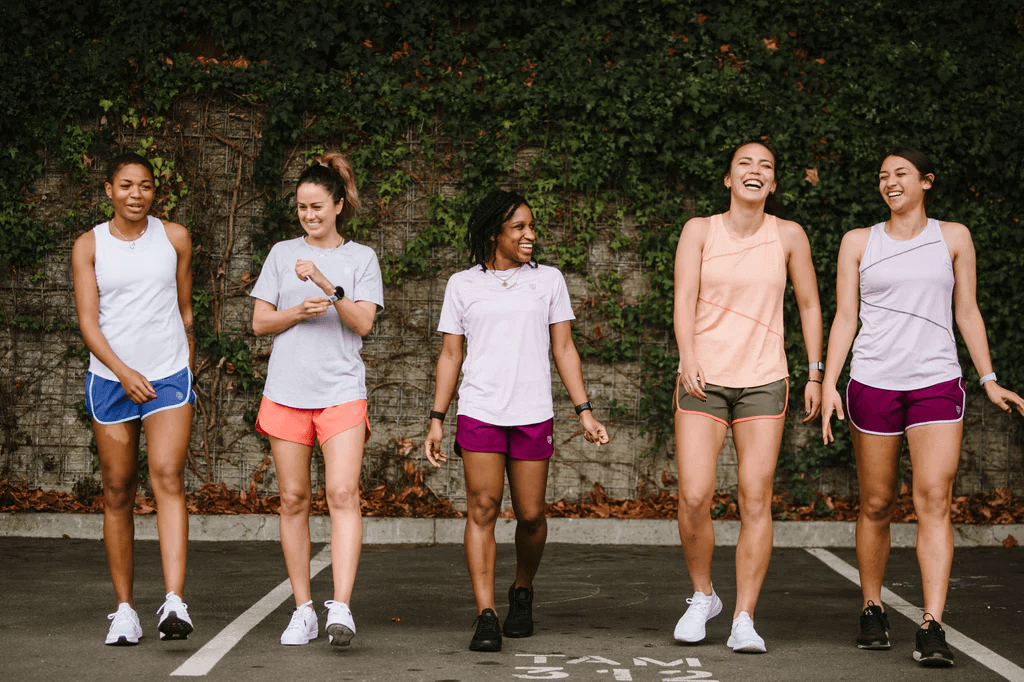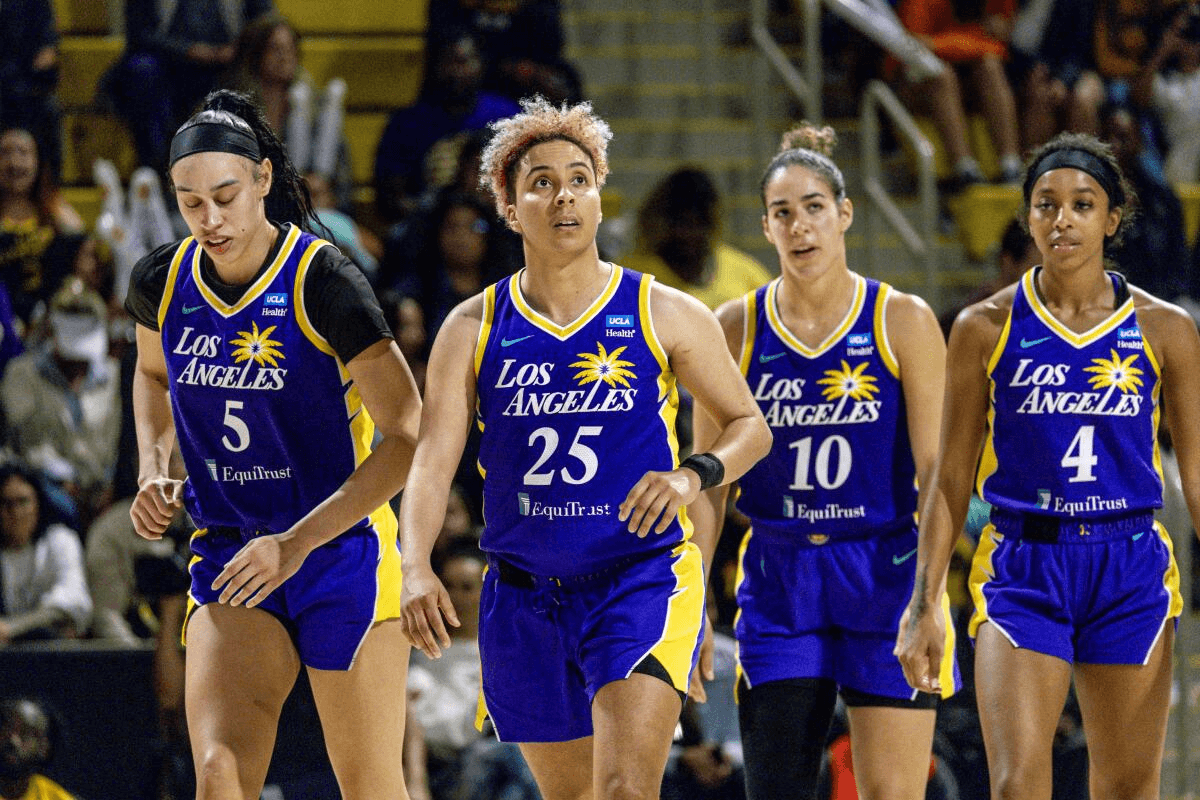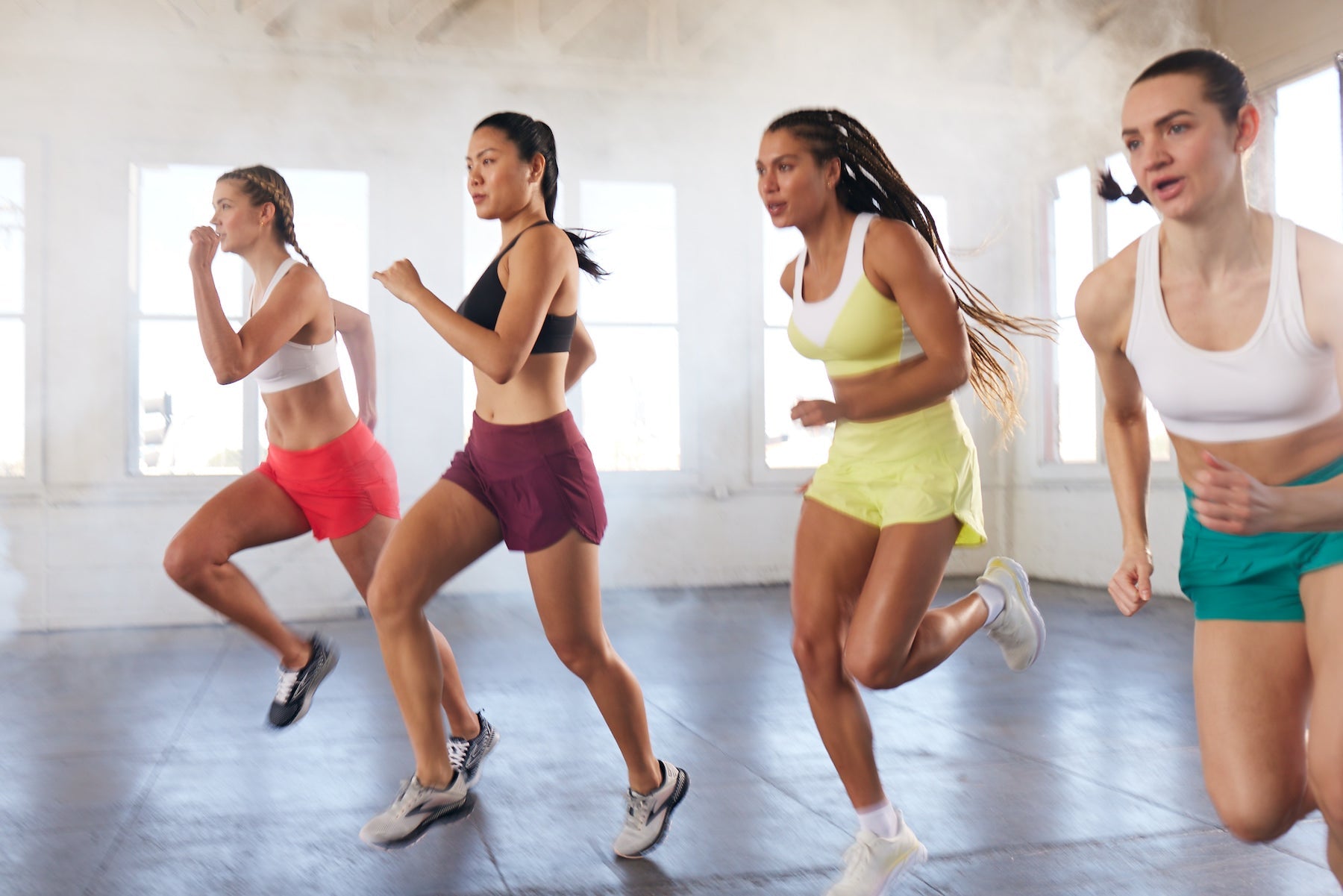Gym shorts are essential to stock up on to wear for any type of physical activity, and knowing the type of materials to look out for is crucial!
Main image courtesy of Ratio Coffee .
When you commit to a daily fitness routine, your priority is to challenge yourself physically and mentally. You’re focused on proving you can reach and exceed each goal on the road to your full potential.
Don’t forget — what you wear to your workouts matters even more than you might think. In one study of 2,000 people, almost nine out of ten participants agreed that putting on gym clothes motivates them to show up on days they didn’t feel like it. Additionally, 85% of gym-goers said looking good in gym clothes provides a workout confidence boost.
Workout clothes’ effect on how you feel has a real basis in psychology. Enclothed cognition is when the psychological and physical experience of wearing certain clothes influences mood.
Dressing the part can activate problem-solving, focus, motivation, and feelings of power and competence.
No matter your individual exercise style, it pays off to track down workout clothes that flow with your body, personality, and preferences while meeting practical lifestyle needs.
Are you a runner who favors clothes that incorporate mesh? Do you need spandex for weightlifting or yoga? Or are you the type of person who dabbles in every kind of exercise and needs clothes that do it all, too?
Nine Types of Gym Shorts Materials
Get familiar with what there is to offer to get the most out of your workout!

When comparing pairs of athletic shorts, take a peek at the description or that label sewn into the seam to answer the question, “What kind of material is used for gym shorts?” Here’s everything you need to know:
Cotton
Cotton is soft and breathable, making it one of the most versatile textiles. It’s a natural fiber that resists certain bacteria while trapping less odor than some synthetics. However, cotton can be moisture-absorbent and slower to dry compared to other fabrics.
Moisture-Wicking Cotton
A blend of cotton and moisture-wicking synthetics is a common way to ensure workout clothes are sweat-wicking and breathable, yet warm in cold weather.
Polyester
Polyester is a lightweight and elastic synthetic material that moves with you for a wide range of motion. It’s excellent at drying faster and staying dry longer for a comfortable workout, but polyester can facilitate more bacteria growth and hold odor if not washed regularly enough.
Poly-dri
There are popular proprietary forms of poly-dri fabric, a quick-drying, thin, lightweight microfiber polyester . It often incorporates strategically-placed mesh panels for dry breathability.
Spandex
Spandex is highly flexible, stretchy, and effortlessly enables a wide range of motion. Many women’s sports shorts come in spandex-polyester blends for an ideal balance of lightweight dryness and unrestricting flexibility.
Nylon
Nylon is another plastic-based synthetic textile that’s versatile and durable. It keeps you warm or cool as needed and dries off quickly with low absorbency.
Bamboo
Natural bamboo fiber is hypoallergenic and gentle on sensitive skin. Its breathability and moisture-wicking helps it stay cool and fresh-smelling, but bamboo workout clothes are not always budget-friendly.
Merino Wool
This is a must-have for staying warm during cold weather outdoor activities. Wool provides incredible warmth but the disadvantage of easily getting waterlogged. Since merino blends wool and moisture-wicking fabric, it balances body heat insulation and dryness.
Polypropylene
Polypropylene is a plastic-based synthetic that’s extremely waterproof, thin, and flexible. These properties make it ideal for staying dry in the elements.
Which Gym Short Material Is Best for Different Workouts?
A breakdown of what types of shorts are more comfortable and useful for different workouts is crucial to know!

Workout specific shorts are important to get familiar with as they can enhance the specific physical activity you’re doing. Image courtesy of Dressember .
Now that you know about the basic properties of some prevalent athletic shorts materials, you may be wondering how these fabrics’ characteristics translate to your favorite workouts.
It all depends on how you exercise, including intensity level, range of motion, and environmental conditions like temperature and precipitation. These determine whether you need a gym shorts material that embodies breathability, moisture-wicking, stretch/compression, and/or protection from the elements.
Cotton for Casual Exercise
As a comfortable and breathable fabric that keeps you cool, cotton is fine for a casual walk, hike, or bike ride. Even if you break a slight sweat walking your dog on a sunny day, you probably won’t have to worry about excess sweat or bacteria buildup during your coffee run or weekend lunch.
Moisture-Wicking Cotton for Moderate Workouts and Cool Weather
Moisture-wicking cotton is slightly better at resisting moisture. Try this material for workouts that don’t leave you sweating heavily. While moisture-wicking cotton will help keep you warm in cool weather, it’s not ideal for precipitation or very cold conditions.
Polyester for Daily Cardio and Strength Training
Polyester shorts are an approachable choice for an everyday fitness routine. Those who work out several days per week may have a rotation of versatile polyester or polyester blend garments due to the stretchy, fast-drying, moisture-limiting comfort.
Unlike cotton, which can soak up sweat and become bunchy and heavy, breathable fabrics like polyester workout clothes for women can improve performance instead of weighing you down. When you wear moisture-wicking polyester to exercise, it draws sweat away from your body and helps control your body temperature, letting you stay in your zone longer.
Poly-dri for High Intensity Workouts
This specialized lightweight variation of polyester may be ideal for ultra-strenuous or HIIT workouts. Its unique texture and mesh paneling keeps you remarkably dry even when pushing your limits.
Spandex for Running, Biking, Yoga, and Weightlifting
Spandex has that extra level of stretch for a wide range of motion in yoga or weightlifting. Spandex shorts, like the Slide Force by GoalFive , are a second skin that eliminates distractions, moving with you yet staying in place no matter how you move, stretch, or bend.
Spandex is a popular compression biking/running shorts material. While compression shorts often contain polyester, polypropylene, bamboo, merino wool, and more, spandex is usually the main ingredient.
Spandex compression shorts apply pressure to the upper leg for reduced muscle damage, inflammation and pain. Studies show compression clothes can somewhat improve runners’ time to exhaustion, perceived exertion, muscle fatigue, and body core temperature with significant effects on post-workout leg soreness and delayed-onset muscle fatigue.
Nylon for Rugged Outdoor Activities in Any Weather
Nylon has the amazing stretch of spandex, impressive moisture-resistance and durability. These features make nylon perfect for outdoor enthusiasts like marathoners, rain-or-shine trail runners, and backpackers. Nylon also works for intense weightlifting.
Bamboo for Indoor or Outdoor Exercise of Any Intensity
Bamboo is super versatile because of its moisture resistance, odor resistance, breathability, temperature control, durability, and comfort. You can wear bamboo fiber workout clothes to a hot yoga class, 5k, walk/hike, outdoor practice, or on strength training day to stay fresh, dry, and cool.
Merino Wool for Outdoor Activities in Cold Weather
Since it’s best for staying warm and dry outdoors, many merino wool athletic shorts you’ll find are compression shorts and base layers. Merino wool facilitates warmth and dryness under outer layers on a brisk winter jog or a day of skiing or snowboarding.
Polypropylene for Exercise in Extreme Weather Conditions
While it’s possible to find polypropylene shorts, it’s not a common material for gym shorts since most people prefer longer layers for exercising in the rain, sleet, and snow. Polypropylene is usually found in compression shorts and underlayers for getting active outside in extreme heat, cold, and precipitation.
Do You Need Gym Shorts with Liners or Without Liners?
Gym liners can be supportive and help keep moisture away!
Many women’s shorts include liners inside to help keep moisture away and provide support for sports and physical activities. Image courtesy of Urban Pitch .
Some gym shorts have liners for support and moisture reduction. They’re typically meant for running or other activities involving a lot of movement. Liners can provide coverage and comfort, and runners may prefer to forego compression shorts by wearing lined gym shorts instead.
On the other hand, some workout shorts liners are simply built-in compression shorts that provide the same benefits as standard compression shorts.
You can use lined gym shorts for almost any workout. For runners looking for an alternative to gym shorts, or if you just want heightened comfort, support, dryness, or even coverage, lined shorts might be for you.
Athletic shorts’ liners should be a soft, breathable, moisture-wicking material like mesh. They should have texture and seaming that prevent chafing, and a snug fit that lays still against the body without squeezing or pinching.
What to Look For When Shopping for Gym Shorts Based on Material
Knowing how to shop for gym shorts and what to look out for is important to get the most out of your workout down the line!
There are many types of workout shorts that are made out of different materials. Image courtesy of GoalFive .
When buying gym shorts that last and jive with your exercise habits, look at the materials with these variables in mind. How much moisture, bacteria, and odor does the textile retain? How thick is the fabric? Does it stretch while maintaining its shape over time? Is it comfortably fitted and practical?
Moisture and Odor Control
Weight
Stretch
Fit
Durability
Utility
How to Measure Yourself for Spandex Shorts When Buying Online
Spandex shorts can be difficult to buy if you’re looking for something ultra-comfortable for any workout!
Spandex shorts are tight, form-fitting clothing that can help to keep muscles in place and can be worn to do a multitude of workouts. Image courtesy of GoalFive .
Especially if you’re searching for close-fitting spandex gym shorts with a seamless, second-skin feel, fit is everything. Knowing how to get accurate measurements of your body can help you pick out the perfect pair of shorts.
Measure the Right Places
Waist: Locate the point just above the belly button and below the bottom rib
Hips: Measure around the widest part of your hips
Thighs: Get the circumference around your upper thigh
Have the Right Measuring Tool
Assume a Natural Body Position
Wear Tight Clothing When Measuring Yourself
Know What Rise and Inseam Length You Like
The Best Gym Shorts to Purchase
Choosing athletic shorts shouldn’t be difficult, and these are some of the best pairs to purchase!
A good pair of athletic shorts is important to have no matter the workout that you enjoy doing. Image courtesy of GoalFive .
There are many types of athletic shorts to purchase and now that you have an understanding of what materials to look out for whenever buying a pair, it now comes down to picking which ones are best for you.
Here are some of the best gym shorts that you can purchase perfect for many types of exercises:
GoalFive’s Excel Women's Workout Shorts
GoalFive’s Excel Women's Workout Shorts are great to wear for any type of workout with its stretchy and flowy fit. Image courtesy of GoalFive .
When choosing a good pair of workout shorts, GoalFive’s Excel Women’s Workout Shorts are among the best to get. These shorts provide a flowing fit that will complement your body, plus they are super stretchy and can be worn for many kinds of fitness activities. Made out of 90% polyester and 10% spandex, these shorts can be great cardio, strength training, weight lifting, yoga, and even bike riding for comfortability throughout the entirety of your workout.
GoalFive’s Slide Force Women's Spandex Shorts
GoalFive’s Slide Force Women's Spandex Shorts are great for compression, are comfortable, and are form-fitting for any type of workout. Image courtesy of GoalFive .
Spandex shorts are very popular for many women to wear because they are comfortable and stretchy, which allows your body to move the way you need it to no matter the workout you’re doing. GoalFive’s Slide Force Women's Spandex Shorts are the perfect fit for any workout because they conform to your body that supports but doesn’t squeeze, and is made out of a stretchy and soft polyester and spandex combination.
GoalFive’s Indie Women's Sport Shorts
The Indie Women's Sport Shorts by GoalFive are a great option to choose whenever you need a full range of motion for any workout. Image courtesy of GoalFive .
It can be difficult to find a pair of gym shorts that are made out of non-restrictive material, but Indie Women's Sport Shorts by GoalFive are an incredible option. These shorts are made out of 90% polyester and 10% spandex that have a higher waist for comfort. They are also made out of a four-way stretch material that is great to move around in, stretch, and bend the way that your body needs to during your workout without any limitations.
GoalFive’s Freasy Shorts
Cotton shorts are great to wear for low-intensity workouts and even casual wear and GoalFive’s Freasy Shorts are a top choice. Image courtesy of GoalFive .
There is no doubt that cotton shorts can be the most comfortable because they provide a ton of breathability for your workout. If you’re someone who loves low-intensity workouts, or need to do something light on a rest day, GoalFive’s Freasy Shorts can be a great option. These shorts are perfect for walking, yoga, tai chi, or even hiking and they are made out of 100% cotton and have a loose and roomy fit without looking oversized.
What’s Your Favorite Gym Shorts Material?
Are you all about spandex compression shorts, polyester blend running shorts with liners, or loungewear-style cotton for a relaxing walk? What’s the best fit and material for you?
Tell us on Instagram @goalfive, and check out some of our best workout shorts for women — you might find your new favorite pair!




1 comment
John Carter
Hello, would you like to grow sales and conversions for your online store? Start Free Trial, No Upfront – No Contract – Free Trial.
I do SEO Marketing and improve Website Traffic, Website Rankings, Organic results, Sales& conversions.
I am a Software Engineer & have more than 12 years’ of experience in Search Engine Optimization Marketing. Our every client gets amazing results & appreciated; please check the results of the latest projects.
Latest Results: https://webcfx.com/latest-projects
Start Free Trial: https://webcfx.com/seo-package/
Thank you
Leave a comment
This site is protected by hCaptcha and the hCaptcha Privacy Policy and Terms of Service apply.